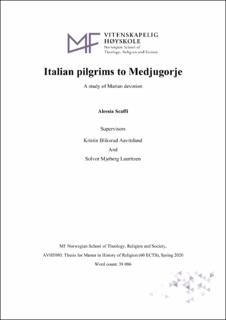| dc.description.abstract | The main topic of my thesis is the study of Italian pilgrims to Medjugorje. The thesis is divided into two main parts. In the first part there are three main sections. The first is the theoretical landscape of my research, mostly focusing on the books Image and Pilgrimage in Christian Culture by Victor and Edith Turner and Moved by Mary: The Power of Pilgrimage in the Modern World edited by Anna-Karina Hermkens, Willy Jansen and Catrien Notermans.
The second focuses on the analysis of two previous Marian pilgrimages, Lourdes in 1858 and Fatima in 1917. The description of the two Marian pilgrimages will mainly refer to the book Encountering Mary. From La Salette to Medjugorje by Sandra L. Zimdars-Swartz. Medjugorje is compared to the two sites. The last section describes the apparitions of Medjugorje and the history of the small village during communism and the war in the former Yugoslavia. Present controversies of Medjugorje are discussed: the rivalry between the Franciscans and the Bishop of Mostar, the position of the Roman Catholic Church and the wealth of the seers. These three sections (the theories, Lourdes and Fatima and the History of Medjugorje), define the first part of my thesis. The first part is therefore theoretical.
The second part of my thesis is empirical because it focuses on the interviews of Italian pilgrims who have gone to Medjugorje and field notes based on my observations during the journey at the shrine. The main research questions are: Why do Italian pilgrims go to Medjugorje? What does Mary mean to them? How does this specific pilgrimage affect their lives? The interviews are analyzed and categorized according to the theories studied in the theoretical section. According to my research, all the Italian pilgrims I interviewed had some sort of problem in their lives, therefore the pilgrimage to Medjugorje. Marian devotion reassures and comforts pilgrims who feel lonely and depressed. Whether walking to the hill of the apparitions, or while praying the rosary, Italian pilgrims strengthen their relationship and connection to Mary, whom they call “autostrada,” the highway to God. Mary is perceived as the celestial mother of all humanity. The Virgin is seen as the medium through which one can reach the Sacred. | en_US |
